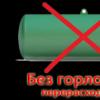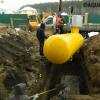As heating devices, not only radiators can be used, but also factory and self-made heating registers. Previously, such heaters were installed most often in garages, warehouses, industrial shops and other commercial facilities. In order to reduce the cost of installation of autonomous heating systems, similar products began to be used in residential low-rise buildings. It is immediately worth noting that space heating with heating registers is less efficient compared to batteries. The latter benefit due to the larger heat transfer area formed by additional plates that are absent in the registers of the basic design. If desired, the owner of the object can eliminate this drawback by welding vertically oriented metal plates to round pipes. Otherwise, this problem is still solved by increasing the number of welded pipes of smaller diameter. Such a modification of the design of heating registers is resorted not only to increase the heat transfer of the device, but also to implement design ideas.
For the manufacture of heating registers, smooth-walled pipes of the same diameter and the same length are prepared. The diameter can range from 32 to 80 mm. Wider pipe products should not be used, because domestic boilers will not be able to provide a sufficient amount of heating medium to the heater. The registers will not be able to warm up well, which means they will not provide heat to the room in which they are installed.
Via gas welding or electric welding, these workpieces located parallel to each other are welded together with pipes of a smaller diameter. According to these transverse tubes (pipes), the coolant circulating in the heating system of the house flows.
Classic heating register designs
Option # 1 - horizontal register
Most often, in the manufacture of the heating register, two or three parallel pipes are laid, laid in the horizontal direction. The distance between adjacent sections in the register must necessarily be 50 mm larger than the diameter. The coil designs of registers are also popular, subdivided into several types depending on the method of connecting devices to the heating system.

Coil type heating registers: L - length of the heater, D - pipe diameter, h - pipe distance (more than 50 mm in diameter)
The length of the heating devices is selected in accordance with the dimensions of the room or room in which it is planned to install the heating system. In addition to the listed types of designs of heating registers, there are also:
- single-tube products;
- four-pipe devices;
- five-pipe models, etc.
The number of pipes used in one heating register depends on the area of \u200b\u200bthe room to be heated, the quality of the object's insulation, the presence of other sources of heat in the room, etc. By sorting the possible pipe diameters, the optimal product sizes are calculated at which the optimum temperature regime will be maintained in the heated room.
Horizontal heating registers from smooth pipes used for lower piping. At the same time, the products are neatly placed around the perimeter of the room closer to the floor surface. In a residential building, pipes go under the windows. In industrial premises, the location of heating devices depends on the height of the ceilings, the particular layout of the facility and the placement of industrial equipment.

Heating registers successfully heat social facilities. Maintenance of such heating devices is much simpler than cast iron batteries.
Option # 2 - Vertical Registers
When redeveloping apartments and expanding their living space with balconies and loggias, you have to dismantle the batteries installed by the developer when the property was commissioned. In this case, the dismantled radiators are replaced by vertical heating registers, welded from a large number of round pipes of small diameter. These heaters are placed in a wall located next to the window opening.
If necessary, the vertical heating registers are closed with decorative grilles, which turn a mandatory element of the heating system into an interior decor item. You can mask the location of the "bundle" of parallel pipes with the help of mirrors, colored glass, mosaics, wrought iron lattices, as well as by placing shelves, hangers, cabinets and other useful items of bulky furniture.
To ensure the movement of the coolant in the vertical register installed in the autonomous heating system of a private house, you can use a circulation pump. Horizontal registers are also used in the natural circulation of the coolant, if their installation is carried out with a slight slope (0.05% is enough).
How many registers will it take to heat a house?
Pipes leading the coolant to the heating devices can also be considered registers to some extent. And the heated towel rail installed in each bathroom is also a kind of heating register. When calculating the exact number of heating registers necessary for comfortable heating of a room, a number of factors are considered that affect the amount of heat loss:
- the thickness of the bearing walls and the material of their manufacture;
- glazing area;
- number of doors;
- floor and ceiling insulation;
- orientation of the house to the cardinal points, etc.
A simplified calculation takes into account the heat transfer of one meter of pipe. For example, it has already been estimated that with one running meter of a 60 mm diameter pipe, one square meter of the living space of the room is heated (provided that the ceiling height is not more than 3 m).
If you buy ready-made heating registers instead of radiators, then you will not be able to achieve significant savings. It is possible to reduce financial costs only in the case of self-production of register-type heating appliances from materials purchased in bulk with discounts on the market. Welding work must also be done by hand. Otherwise, the cost of the services of a professional welder will block all the benefits from the wholesale purchase of pipes and fittings.
Mounting methods: welding or carving?
The biggest problem during installation work on the assembly and installation of heating registers are welding work. Heating devices are assembled from individual parts outdoors, and then from the prepared blanks, the heating system is installed using gas welding. Welds can be replaced by threaded connections, which are inferior to them in strength and durability, but, subject to the technology of work and the use of modern materials, can ensure continuous operation of heating equipment.

The heating register in a garage or warehouse is an independent device that allows you to heat a technical room with electricity
Homemade round tube registers
You can purchase home-made heating registers sold by professional welders on the market. If the finished products are not suitable for you in size, then the welders will produce heating appliances on an individual order. The quality of home-made products is not in doubt, so they are built into autonomous heating systems without fear and risk.
“Samovars” with heating elements are also popular with consumers. So called heating registers, which independently heat individual rooms due to electricity. Instead of water, oil, antifreeze or any other non-freezing liquid is poured into the pipes. Heating of the coolant is carried out by a conventional heating element, operating from a network with a voltage of 220 V. “Samovars” in their design resemble oil radiators produced in the factory. "Samovars" are used in extensions where it is impossible or inexpedient to build a water heating system. Heating devices operate in an autonomous mode, while their performance depends only on the availability of electricity.

A samovar is one of the types of heating registers that are not connected to the home heating system, but heat one of the rooms with electricity
Homemade register from a profile pipe
To make a heating register from a profile pipe, a product of rectangular cross-section (60 by 80 mm) is chosen with its own hands, the wall thickness of which is 3 mm. A home-made heating battery (register) is assembled in several stages:
- first cut the pipe into several parts of a certain length;
- then, on the workpieces, markings are made for the holes into which the jumpers will be welded;
- make four jumpers from an inch round pipe (25 mm);
- stubs are cut from a 3 mm sheet of metal, the size of which is determined by the rectangular cross-section of the profile;
- cut out holes for jumpers in the places of the marked markings, while in the upper and lower pipes of the register there should be two holes on one side, and in the middle pipe - four holes (two on both sides of the part);
- on wooden supports (timber) lay three pipes parallel to each other;
- jumpers are inserted into the holes in the pipes, the parts are aligned according to the level, and each jumper pipe is tacked in three places by electric welding;
- after product with horizontal position turn upright;
- begin to boil all the tacked jumpers into two seams, adjusting the strength of the welding current to prevent the formation of places of possible leaks;
- after the profile pipes are cleaned of slag and metal debris that has fallen into the cavity of the product;
- pre-assembled plugs are applied to the ends of the profile pipes, they are gripped diagonally, and then they are thoroughly boiled along the entire perimeter of the rectangular section of the profile;
- grinder lightly grill the cooking seams throughout the heating register;
- in the upper pipe of a home-made register a hole is cut out under the Mayevsky crane;
- the register can be connected to the heating system from below, from the side, from above, or by a combination of the above options (from below and above, diagonally, etc.):
- the outlet opening is closed with a plug, the register is filled with water, after which the master looks through all the welded joints, eliminating the possibility of leakage through microcracks;
- weld floor supports from steel corners or brackets that allow you to mount the device on the wall.
Such a register has a high heat transfer due to the large amount of coolant flowing through the profile pipes. Jumpers should be located as close as possible to the end edges of horizontal parts. The coolant is supplied through the inlet pipe located in the upper pipe. After passing all the elements of the device, the coolant flows through the outlet pipe located on the lower pipe.

The heating register of four parallel pipes connected by side pipes, risers, heat the living room
As you can see, it’s not difficult to make a heating register with your own hands if you have a welding machine and experience with it. Home-made heating appliances can be welded in exact accordance with the dimensions of the heated room. To buy a ready-made heating register, you will have to prepare three times more money than to purchase all the necessary materials for self-welding of the product. To ensure long-term operation of the device, pipes from carbon steelstainless low alloy steel or cast iron.
Recently, for heating industrial, warehouse and residential premises, special heating registers (RO) are increasingly being used - heating devices that consist of long smooth-walled pipes located around the entire perimeter of the room. As a rule, pipes are placed parallel to the floor and interconnected by jumpers from pipes of smaller diameter, which are also filled with coolant. The simplest example of a heating register is a heated towel rail in a bathroom.
Types and specifications of heating registers
There are several varieties of these devices. Heating registers are classified by material, form of execution and installation method. Let us consider in more detail each group of these devices.
The principle of operation of the device
According to pipe material
- Steel heating registers
The most popular type are appliances made of steel. It is worth saying that steel is a fairly durable material. It is perfectly welded, while it has quite good thermal conductivity.

Sectional RO of steel pipes
- Aluminum devices
Devices from aluminum are somewhat inferior in popularity to steel ones. Nevertheless, they also have some advantages: they weigh a little, look attractive, are more resistant to corrosion, and give off heat well. The only and main drawback of aluminum pipe heaters is their price.
- Cast iron registers
The least popular are the registers of cast-iron pipes. Despite the cheapness, this material is quite fragile and is afraid of mechanical damage. In addition, it does not weld well, which greatly complicates installation.
According to the form of execution
RO can be performed in two main forms:
Sectional - they make such heat exchangers from one or several smooth-walled pipes with a diameter of 25 to 400 mm, which are closed with plugs and connected to each other by nozzles. The coolant enters the upper section through the pipe, and at the opposite end flows to the next section, etc.
S-shaped (coil) - pipes are connected by arcs, i.e. it turns out one continuous pipe. This form allows you to use the entire surface of the device, which leads to an increase in the effective area of \u200b\u200bthe heat exchanger.

Sectional and coil RO
By installation method
Also, heating registers are divided into stationary and portable. Mobile or portable devices of this type are most often used in rooms where it is necessary to temporarily maintain the set temperature before installing the main heating system. For example, during the construction of a new building, or in the garage during repairs. Synthetic oil or antifreeze is used as a heat carrier in such systems, and heat energy is generated by electric heating elements.
Advantages and disadvantages of RO

Sectional register consisting of two sections
Among the advantages of these devices are the following:
- High reliability and durability. Such heaters do not require special attention during operation and at the same time serve for quite some time. Steel pipes will not need repair for at least 25 years. If the welding work is performed efficiently, such a device can work even under high pressure conditions, which is ideal for rooms with central heating.
- Low resistance to movement of the coolant due to the large diameter of the pipes.
- Quickly and evenly warm large areas.
- Heating devices can be made according to individual drawings of the developer.
Of the disadvantages it is worth noting:
- Bulky and specific appearance. The large-diameter pipes installed around the entire perimeter of the room “steal” the usable area and are not too pleasing to the eye, although with the right approach, you can originally fit them into the room design concept, making the RO an interesting addition or even a highlight of the interior.
- Difficulty in installation. If the heating system based on radiators and plastic pipelines can be mounted independently, if desired, then the installation of heating registers should be carried out only by specialist welders.
Calculation of the required number of registers
For the correct calculation, you need to take into account the following parameters:
- area of \u200b\u200bthe room;
- heat transfer per square meter of the surface of the material from which the registers are made.
- the diameter of the pipes that will be used for the manufacture of heating appliances.
An approximate calculation of heating registers depending on their diameter is shown in the table below.
The data in the table are indicated when the ceiling height in the room is not more than 3 meters. That is, to heat a garage with an area of \u200b\u200b60 meters, you need 64 meters of pipe with a diameter of 57 mm or 30 meters of pipe with a diameter of 133 mm. After calculations, you need to make drawings. In addition, you should consider all the nuances of the location of the PO in the room.

To summarize. ROs may well compete with other types of heating appliances. It is necessary to select the optimal configuration of equipment individually in each case, taking into account the characteristics of the premises and the wishes of the owner of the house. The manufacture of heating registers and their installation is best left to professionals.
Video: homemade battery (register)
To supply heat in residential and public buildings, heating registers from smooth pipes are installed. These are devices that are designed to increase the degree of efficiency of heat exchange between the external environment and the coolant.
The registers consist of several smooth-walled steel pipes connected by special pipes of a smaller diameter. In their form, they resemble a zigzag or “fence”. In this regard, sectional, coil, registers from smooth pipes with columns, registers with heating elements are distinguished.
Heat exchanger features
Section Registers
Such devices consist of one or several pipes at once, which are closed with plugs. Through the pipe hot water enters the upper pipe, and then flows into the next one, located one level lower. By this principle, water is distributed over all parts of the device.
The transition from one section to another is done as close to the edge as possible to ensure a sufficient flow of the working medium and high heat transfer.
Such a heat exchanger is made of steel pipes with a diameter of 25 to 400 mm. Widely used registers of smooth pipes with a diameter of 76 mm, 89 mm, 108 mm, 159 mm. The nozzles for entry and exit are made threaded, flanged or welded. The plugs are flat or elliptical. A threaded fitting is included in the kit for such a device, to which an air vent is connected. The heat exchanger can withstand a working pressure of 10 kgf / cm 2 or 1 MPa.
Coil heat exchangers
This type of heat exchanger is made from one solid pipe. Smooth-tube s-shaped registers are effective in their heat transfer, since the entire surface of the pipe gives off heat.

Heater coil shape
Another advantage - this configuration does not provide for the presence of sections of pipe narrowing. This feature prevents rising hydraulic resistance.
Traditionally, heating registers are made of smooth-walled steel, often carbon, although home-made cast-iron models, stainless steel or low-alloy steel pipes are also found.

Pipes for register heat exchangers
The compactness and high efficiency of the registers allows them to be widely used in the construction of residential, office premises and those facilities that are characterized by increased sanitary and fire standards.
Heater registers
Devices with a heating element are installed in those rooms where there are problems with the laying of communication lines.
The power of the heating element ranges from 1.6 to 6 kW at a voltage of 220 V. In operation, the heater maintains the surface temperature of the register within 80 ° C.
To increase the efficiency of heat transfer processes, the device is equipped with a circulation pump.
Working as an element of the central heating system, the heater responds to lower and higher temperatures. Accordingly, it either compensates for heat loss or, on the contrary, turns off.
Such heat exchangers have many advantages:
- fire safety;
- easy accessibility during cleaning;
- large heat transfer area;
- frugality;
- multifunctionality.
Production of heating registers
Preliminary calculations
To make the heat exchanger with your own hands, you need to perform register calculation from smooth pipes.
- Formula
The basis of the calculations is the following formula:
Q \u003d Pi x dn x l x k x (tg - to) x (1 - ηf),
wherein
the number of Pi is 3.14;
dн - outer diameter of the pipeline (in meters);
I - section length (in meters);
k - coefficient (equal to 11.63 W / m² * ° C);
to - temperature in the room intended for installation of the device;
tr is the temperature of the working medium in the pipeline;
ηiz - coefficient of heat preservation by insulation (if the device is not insulated, this coefficient is equal to zero, if insulation exists, ηiz \u003d 0.6 ÷ 0.8).
The result will show the thermal power for the registers of smooth pipes, which is applied to one horizontal pipe. If the device has several rows, a reduction factor of 0.9 is used for each additional row.
If you are having difficulty figuring out a register from smooth pipes, find online calculators. As practice has shown, this method of solving the problem is not always accurate, therefore, it is recommended that the result be rechecked by the formula and only after that proceed with the manufacture of the device.
- Standards
Installation of registers is carried out according to GOST standards. For fixing, you will need a welding machine, since the mount must support the weight of the working medium and the weight of the heat exchanger itself.
Characteristics
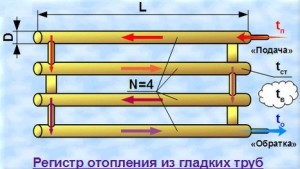
The principle of operation of registers from smooth pipes
Smooth tube registers have the following specifications:
- do not require the use of highly professional equipment (use an angle grinder, electric welding);
- large rooms are heated, while having only a register of 2 or 4 smooth pipes;
- made of available material (stainless steel, steel, cast iron);
- available for various working environments (work not only on water, but also on steam, oil and other liquids);
- multivariate in their form, the use of fittings, coating materials, plugs;
- in the manufacture of possible use of drawings of reuse;
- available at their pricing policy.

Register of smooth pipes in a living room
The register of the heating system is a device made of smooth-walled pipelines. According to its design features, the register served as the basis for most radiators. Very often, these devices are located in technical and industrial premises. In addition, there are cases when they are installed in apartments as part of autonomous heating systems. However, not everyone knows how to calculate the heat transfer of the register.
Main types and specifications
There are several main varieties of these heating appliances. Registers are classified by installation method, form of execution and material. Therefore, before calculating the registers from smooth pipes for heating, we will consider in more detail each group of these devices. 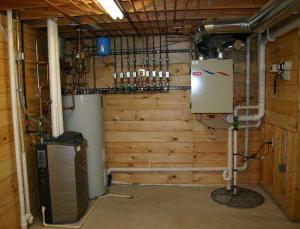
According to the form of execution
- Sectional registers. Such heat exchangers are made of one or more smooth-walled pipelines with a diameter of 25 to 400 mm, interconnected by nozzles and closed with plugs. The coolant through the pipe enters the upper section, and flows to the next section at the opposite end, etc.
- Coil (S-shaped) devices - pipelines are connected by arcs, resulting in a continuous pipe. This form allows you to use the surface of the device as a whole, which increases the effective area of \u200b\u200bthe heat exchanger. Below we consider how to calculate the heat transfer of a register from smooth pipes.
By installation method
Registers for heating systems are divided into portable and stationary. Portable or mobile devices, as a rule, are used in rooms where temporary support of the set temperature is required before the device of the main heating system. For example, during the construction of a new building or during repair work in the garage. In such systems, antifreeze is used as a heat carrier or heat energy is generated by means of electric heating elements. 
By material
- Steel registers. This is the most popular type of instrument made of steel. It is also worth noting that steel is a fairly durable material. It is perfectly welded and at the same time has good thermal conductivity.
- Cast iron devices. Currently, the most popular registers of cast iron pipelines. But, despite the low cost, this material is quite fragile and unstable to mechanical damage. In addition, cast iron is poorly welded, which makes installation difficult.
- Aluminum registers. In popularity, these devices are slightly inferior to the registers of steel pipes. At the same time, they have several advantages: they look attractive, weigh a little, give off heat well and are resistant to corrosion. The main and only drawback of aluminum registers is the high price.
Heat Transfer Calculation: Highlights
During the installation of the heating system, many are interested in the calculation of registers from smooth pipes. How to calculate that there are not too many of them (it will be very hot) or too little (it will be cool)? 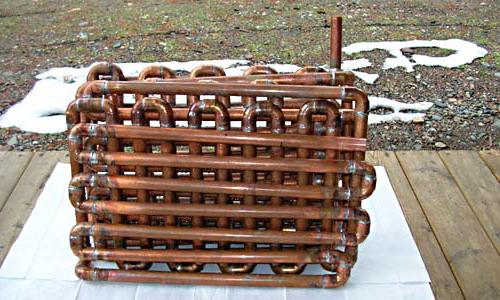
- For a private house or apartment there is no need to calculate the exact figure, since in this case the specific temperature value does not matter. It is important that the temperature regime is optimal.
- The simplest calculation: 2 m 2 should have one section (cast iron or aluminum), 1.5 m 2 - one section (bimetal).
- If the ceiling is more than 3 meters, add one section. If there is a balcony, one or two sections are also added, depending on whether the balcony is insulated or not. A section is added if the room is angular.
- Since the flow temperature of the coolant is regulated for apartments, it is allowed to calculate the heat transfer of the register regardless of the climate.
- In private homes, this calculation is not suitable due to the fact that it enters the system too much. This gives a strong overheat if the building is located in warm regions.
- In addition, the heat transfer calculation of the heating register can be performed using online calculators. To do this, you need to enter some data, and then the program will calculate the required number of pipes.
Calculation Method
When choosing this device, it is important to choose the diameter of the pipelines from which the register will be made. The most optimal diameter is 32 mm, but it is allowed to install registers of another diameter, but not more than 80 mm. If the diameter is more than 80 mm, then the heating system might simply not have enough power to heat up such a device, since the boiler will not be able to supply the required volume of coolant.
In order to correctly select this plumbing element and calculate the heat transfer of the register, the following factors should be taken into account:
- The material of which the structure is made.
- Wall thickness.
- The number of window and doorways.
When calculating the heat transfer of the register, it is necessary to know the heat transfer value of one linear meter of the pipeline. For example, one linear meter of a pipe with a diameter of 60 mm can heat 1m 2 of a room with a height of not more than 3 meters.
The table below shows an approximate calculation of the heat transfer of the register depending on the diameter of the pipelines.
The table shows data with a ceiling height of not more than 3 meters. In other words, to heat 60 m 2, you will need 87 meters of pipeline with a diameter of 40 mm or 44 meters with a diameter of 89 mm. After the calculations, it is necessary to make drawings. You will also need to consider all the nuances of register placement in the room.
Register mounting
When installing the registers, welding is the most expensive, which as a result will become a determining factor when choosing between a radiator and a register. However, you can do without them. The joints in this case are connected with the help of which, despite the fact that they are somewhat inferior to the joints in welding, they can also serve for a rather long time.
During installation of these devices, it is necessary to observe a slight slope (0.05 ‰) in the direction of movement of the coolant.
Conclusion
So, summing up, it is worth noting that the registers are able to compete with other varieties of heating appliances. The most optimal configuration of the device should be selected individually for each specific case, taking into account personal wishes and features of the room. However, the manufacture of heating registers, as well as their installation, is still advisable to entrust to professionals.
Heating registers are one of the simplest types of radiators for heating systems. They are made of smooth or profile metal pipes. Typically, such devices are used for workshops, private workshops, etc.
A distinctive feature of the products is the large volume of coolant contained in the registers. Due to the compactness of the equipment, the coolant heats up quickly. At the same time, the cooling rate is quite low and the heat is kept in the room for a long time.
Design
The device is made of parallel pipes interconnected by a vertical jumper. The pipes used have an increased diameter with a limited length. They differ in shape, number of tubes and their location. 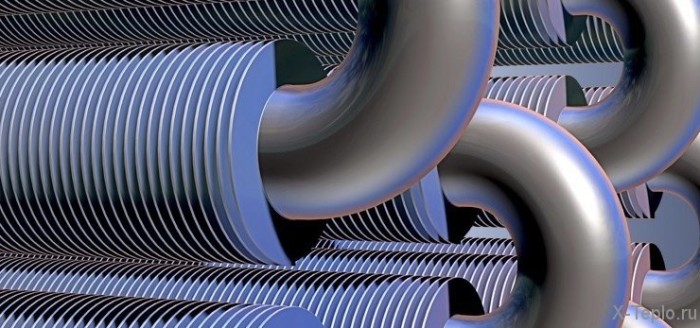 The device has two nozzles: inlet and outlet, and is also equipped with a nozzle for venting air. The most common are 2 types:
The device has two nozzles: inlet and outlet, and is also equipped with a nozzle for venting air. The most common are 2 types:
- sectional;
- coil.
Sectional
Arranged from several pipes with plugs at the ends. The coolant enters the upper pipe, from where it flows into the lower sections through jumpers. The device is designed for a coolant pressure of not more than 10 kgf / cm². 
Coil
The design of such a heating device differs from the first in the absence of tapering sections, because it is a continuous pipe consisting of several arcs welded together. The heat transfer of such a device is slightly higher than that of a sectional one.
main parameters
Most often, heating registers are made of steel, stainless steel or cast iron. The diameter of the products is 32 - 200 mm. Between each other pipes are located at a distance of 50 mm, the length of the jumpers is 32 mm. Connections can be flanged, threaded or welded type. 
Benefits
The efficiency of heating a room through registers is much lower than when using conventional batteries. Nevertheless, these heating devices have several advantages, thanks to which they can compete with standard radiators:
- resistance to temperature and pressure drops;
- the possibility of application in large industrial premises;
- uniform heat distribution;
- easy care;
- the possibility of independent manufacture and installation.
Types of equipment
According to the material of manufacture, heating devices can be of 3 types:
- aluminum;
- steel;
- cast iron.
Aluminum
Aluminum heating registers are lightweight, have high heat dissipation and are resistant to corrosion. They are made using monolithic casting technology without welds and have a long service life. However, the price of such products is quite high.
Steel
 The most common type of equipment. Made of smooth high carbon steel pipes. Mounted welded wayTherefore, special attention should be paid to the quality of the joints.
The most common type of equipment. Made of smooth high carbon steel pipes. Mounted welded wayTherefore, special attention should be paid to the quality of the joints.
Cast iron
 They have a large number of ribs. Their walls are very thick, which is why it takes a lot of time to heat and cool. Bolts are used to connect such pipes. Like any other design, the assembly of cast-iron registers for heating requires the use of gaskets in most cases, rubber.
They have a large number of ribs. Their walls are very thick, which is why it takes a lot of time to heat and cool. Bolts are used to connect such pipes. Like any other design, the assembly of cast-iron registers for heating requires the use of gaskets in most cases, rubber.
Integrated heater
There is another type of equipment - this is a heating register with an electric heater (TEN) inside. As a coolant, antifreeze or oil is added to such devices. It is recommended to install in rooms where there is no way to connect water heating, but there is a source of electricity.
Production and installation
Making registers is quite possible with your own hands. In this case, it is necessary to calculate the optimal motion of the coolant and mount the jumpers between the pipes accordingly.
Preparatory stage
The calculation of the required register power is carried out according to the constant - 1 linear meter of a smooth or shaped pipe with a diameter of 60 mm will heat 1 m2 of the room with a ceiling height of up to 3 m. In this case, it is necessary to take into account the thickness of the walls, the presence of windows and doors and their number, thermal insulation of the ceilings. After calculating the power, a product drawing is performed.  Please note that significant savings can be achieved only with the independent manufacture of heating registers.
Please note that significant savings can be achieved only with the independent manufacture of heating registers.
Professional pipe equipment
At the first stage profile pipe cut into pieces of a given length. In the resulting blanks make marks for the holes of the nozzles. After that, jumpers are welded into horizontally laid pipes, the ends are closed with plugs.  To the upper and lower sections welded nozzles for supplying and returning the coolant. On the other side of the upper pipe, a threaded pipe is welded to connect the vent valve.
To the upper and lower sections welded nozzles for supplying and returning the coolant. On the other side of the upper pipe, a threaded pipe is welded to connect the vent valve.
Products from round pipes
The technical and operational characteristics of devices made of smooth pipes are rather mediocre compared to traditional radiators, which have a radiating screen. To increase the indicators of heat transfer to the pipes, steel plates are welded onto the pipes with their own hands, increasing the area of \u200b\u200bthermal radiation. 
Mounting Methods
The heating registers assembled according to the drawing are mounted in the system by welding or threaded connections. Welds are stronger and more durable, however, high-quality bolt fasteners, made strictly according to technology, will ensure the long-term operation of the heat supply system.



